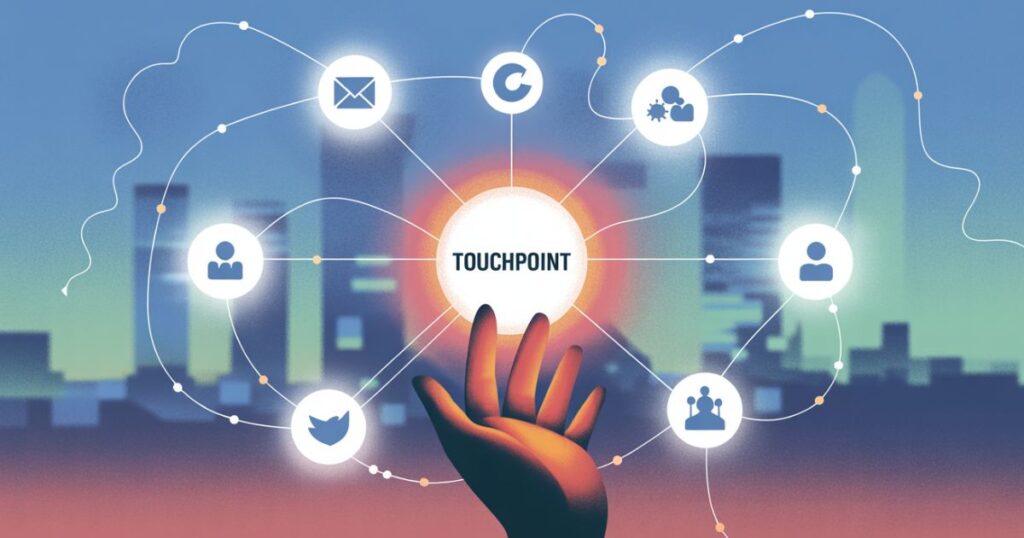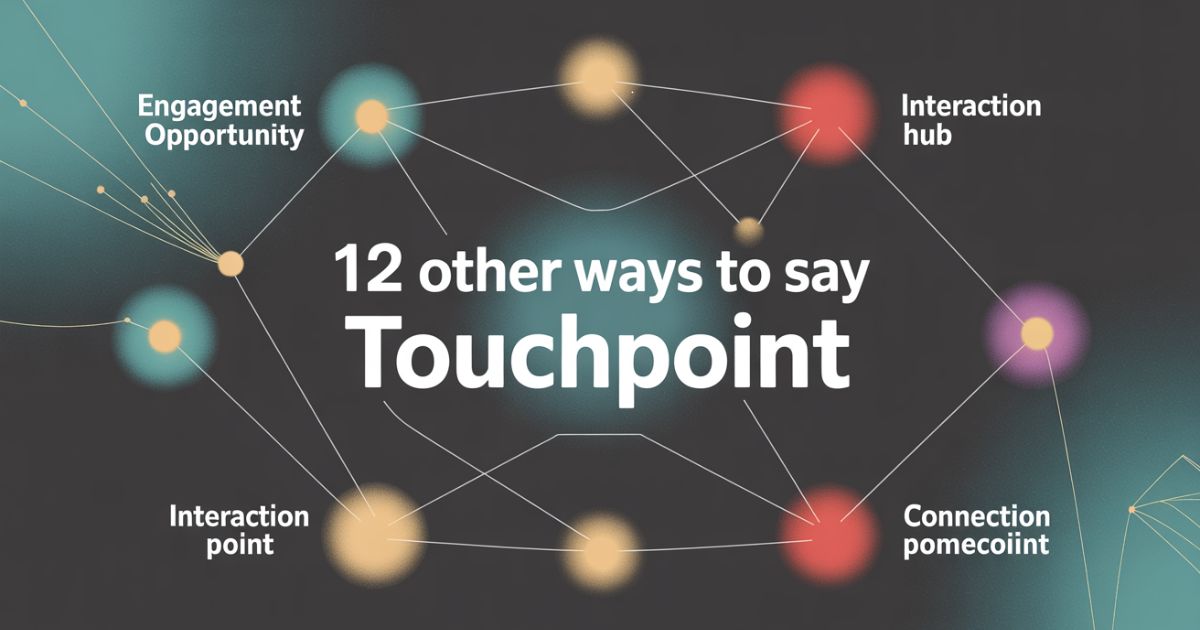A “touchpoint” is any moment when a customer interacts with a business or brand. These interactions can happen in many ways, such as through customer service calls, emails, or social media. Understanding touchpoints is important because they shape a customer’s overall experience and perception of your brand. By identifying and improving these touchpoints, businesses can build stronger relationships with customers.
In this article, we’ll explore 12 different ways to say “touchpoint.” Each term offers a unique perspective on how businesses connect with customers. Whether it’s a point of contact or an engagement opportunity, these terms help businesses communicate better and improve customer experiences.
Other Ways to Say “Touchpoint”
In this section, we will introduce 12 different ways to say touchpoint, explaining their meanings and when they are best used. These alternatives can help diversify your communication and improve your connection with clients and prospects.
1. Point of Contact
Example: “Our customer service team is a key point of contact for clients seeking support.”
Meaning: This term emphasizes the place or moment where customers interact with the company, focusing on direct communication channels. It’s often used in sales, customer service, and business communication to refer to the specific person or medium through which clients can reach out.
2. Interaction Moment
Example: “Every interaction moment, from browsing the website to purchasing, is designed to be seamless.”
Meaning: Highlights specific instances of customer interaction, whether digital or physical, that form part of the customer journey. This term is useful when discussing particular times or events when customer engagement happens, especially in sales or marketing contexts.
3. Engagement Opportunity
Example: “We see every engagement opportunity as a chance to build a stronger connection with the prospect.”
Meaning: This term refers to a chance for deeper interaction, where businesses can engage and connect with customers. It is often used in marketing and sales to describe moments where there’s potential for building a relationship or making a sale.
4. Customer Interface
Example: “Our website is the main customer interface where users can get information and make purchases.”
Meaning: In the world of digital platforms and user experience (UX) design, a customer interface is the medium through which customers interact with your business. It can refer to websites, apps, or even service platforms where customers interact with your brand.
5. Brand Encounter
Example: “A brand encounter at a trade show can leave a lasting impression on a prospect.”
Meaning: Brand encounter focuses on moments when a prospect or client comes into contact with your business, usually creating a brand perception. This term is especially useful in discussing marketing or public relations strategies.
6. Service Touchstone
Example: “A service touchstone like a follow-up call after the sale shows customers we value their feedback.”
Meaning: A service touchstone refers to significant service moments where a business offers value to the customer, such as problem-solving, follow-ups, or offering additional services. This term is used in customer service and support contexts.
7. Connection Point
Example: “The first phone call serves as a connection point between the prospect and the sales team.”
Meaning: Connection point refers to where the relationship begins or an engagement takes place. This term is often used to describe the initial steps in customer engagement or when businesses establish a new relationship with clients or prospects.
8. Experience Intersection
Example: “The experience intersection occurs when customers encounter the brand online and in-store.”
Meaning: Experience intersection describes moments where customers come into contact with multiple aspects of the brand, whether physical or digital. It’s commonly used in customer journey mapping to highlight key moments of interaction that affect the overall experience.
9. Interaction Channel
Example: “The interaction channel could be an email, a phone call, or even an in-person meeting.”
Meaning: This term refers to the medium or platform through which a customer interacts with a business. It’s useful when discussing different ways customers engage with a brand, especially in sales and customer service environments.
10. Customer Touch Zone
Example: “The customer touch zone is where customers interact directly with your sales team or services.”
Meaning: This term focuses on the space or environment where customer interactions are most likely to happen. It can refer to physical locations, such as a retail store, or virtual spaces like a website or social media platform.
11. Engagement Interface
Example: “An engagement interface is how customers experience and interact with the brand on a mobile app.”
Meaning: The engagement interface refers to any platform or medium where a customer can engage with the brand, such as websites, mobile apps, or even social media. This term is often used in digital marketing and UX design.
12. Brand Interaction Point
Example: “The brand interaction point during a webinar allows potential buyers to ask questions and learn more about our services.”
Meaning: A brand interaction point refers to a moment when a prospect or client interacts with the brand, such as during marketing events, sales calls, or digital interactions. It’s useful in discussing marketing and customer engagement.
When to Use Different Expressions for “Touchpoint”

Using different terms for “touchpoint” helps tailor communication to specific contexts. For customer service, “Point of Contact” emphasizes direct support, while in marketing, “Engagement Opportunity” highlights chances for deeper connection.
In user experience or strategic planning, terms like “Customer Interface” and “Experience Intersection” are perfect for describing the critical moments that define a customer’s journey with the brand.
For Direct Customer Service and Support:
- Point of Contact: Use when referring to direct communication channels like customer service lines, focusing on the interaction itself.
- Service Touchstone: Ideal for describing a reliable and consistent source of customer support, such as a help desk or support center.
- Customer Touch Zone: Refers to the specific moments where customers interact directly with the brand, like a phone call or service chat.
- Interaction Moment: Highlights specific instances of customer interaction, whether physical or digital, that are critical to the service experience.
In Marketing and Customer Engagement:
- Engagement Opportunity: Best for moments that offer a chance to connect with and engage customers, especially through social media or email.
- Brand Encounter: Suitable for any situation where the customer interacts with the brand, focusing on the impact of those interactions.
- Brand Interaction Point: Describes the specific moments when customers engage with your brand, either online or offline, and make decisions.
- Engagement Interface: Refers to platforms or environments where customer engagement occurs, like websites or customer portals.
In User Experience and Interface Design:
- Customer Interface: Refers to how customers interact with digital platforms, ensuring smooth navigation and experience.
- Engagement Interface: Focuses on the direct interaction between users and digital interfaces, such as apps, websites, and other tools.
- Interaction Channel: Describes the different communication methods available for customers, like email, chat, and phone calls.
- Experience Intersection: Represents the meeting point where different aspects of the customer experience come together, influencing overall satisfaction.
In Strategic Planning and Customer Journey Mapping:
- Connection Point: Identifies critical stages in the customer journey where engagement is most impactful.
- Experience Intersection: Shows where customer experiences overlap, providing insights into how interactions can be optimized.
- Interaction Moment: Highlights specific customer touchpoints, such as decision-making moments, that affect the journey.
- Engagement Opportunity: Focuses on opportunities to engage customers at key points, improving their overall experience with the brand.
For Digital and Multi-channel Communication:
- Interaction Channel: Refers to the multiple methods of communication available to customers, such as social media, email, and mobile apps.
- Customer Interface: Describes the platforms customers use to interact with the company, like websites and mobile apps.
- Engagement Interface: Focuses on the digital touchpoints where customers interact with the brand’s content and services.
- Interaction Channel: A broader term for all the different platforms through which customers engage with the brand across multiple touchpoints.
For Initial Brand Impressions:
- Brand Encounter: Refers to the initial moments when a customer first comes into contact with the brand, shaping their perception.
- Brand Interaction Point: A critical moment when the customer interacts with your brand, setting the tone for future relationships.
- Interaction Moment: Highlights the first meaningful interaction with the brand, influencing the customer’s overall impression.
- Engagement Opportunity: A key point to make a positive initial connection with potential customers, setting a strong foundation for future interactions.
Conclusion
Understanding different “touchpoints” is essential for businesses to build strong relationships with customers. Each “touchpoint” provides a unique opportunity to engage and connect, whether it’s through customer service, marketing, or sales. By using the right terms to describe these interactions, businesses can create better strategies and improve customer experiences.
It’s important to recognize the value of each “touchpoint” in the customer journey. Every “touchpoint” matters and has the potential to influence decisions. By focusing on these moments, companies can ensure they stay top-of-mind and provide exceptional service. Understanding these “touchpoints” is a must for any business looking to grow and succeed.
Learn About: grammerroot

Grammerroot is your trusted source for mastering English grammar and language skills. From simple rules to advanced tips, we help learners build strong foundations through easy-to-understand content. Learn smart, learn right — only at Grammer Root.




